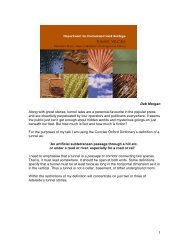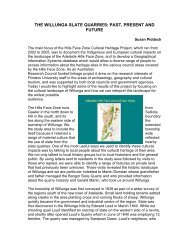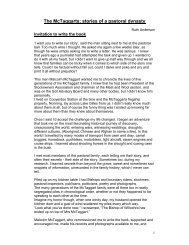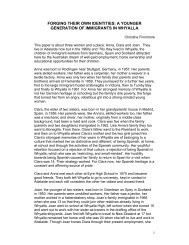Diary of the Trees Hahndorf's reputation as a Bavarian ... - History SA
Diary of the Trees Hahndorf's reputation as a Bavarian ... - History SA
Diary of the Trees Hahndorf's reputation as a Bavarian ... - History SA
You also want an ePaper? Increase the reach of your titles
YUMPU automatically turns print PDFs into web optimized ePapers that Google loves.
<strong>Diary</strong> <strong>of</strong> <strong>the</strong> <strong>Trees</strong><br />
Paper presented by Melinda Rankin for <strong>the</strong> <strong>History</strong> Trust <strong>of</strong> South Australia State <strong>History</strong><br />
Conference, 2 August 2009<br />
Hahndorf’s <strong>reputation</strong> <strong>as</strong> a <strong>Bavarian</strong> <strong>the</strong>med tourist town complete with oompah<br />
bands and liederhosen-clad accordion players h<strong>as</strong> done little to communicate <strong>the</strong><br />
story <strong>of</strong> <strong>the</strong> Silesian settlers who moved to <strong>the</strong> area in <strong>the</strong> 1830s. Nei<strong>the</strong>r h<strong>as</strong> it<br />
acknowledged <strong>the</strong> significance <strong>of</strong> <strong>the</strong> land for <strong>the</strong> Peramangk people or enhanced<br />
<strong>the</strong> region’s role (p<strong>as</strong>t and present) <strong>as</strong> a productive food b<strong>as</strong>ket for Adelaide.<br />
The Hahndorf Academy h<strong>as</strong> been presenting <strong>the</strong> region’s history for <strong>the</strong> l<strong>as</strong>t forty<br />
years, mostly through <strong>the</strong> display <strong>of</strong> objects from its collection. The organisation is<br />
currently in <strong>the</strong> process <strong>of</strong> re<strong>as</strong>sessing this display, exploring methods <strong>of</strong> engaging<br />
our community and visitors with au<strong>the</strong>ntic stories from pre-settlement to <strong>the</strong><br />
present day.<br />
1
<strong>Diary</strong> <strong>of</strong> <strong>the</strong> <strong>Trees</strong> w<strong>as</strong> a temporary public art installation undertaken for <strong>the</strong> South<br />
Australian Living Artists Festival in August 2008. An artist w<strong>as</strong> engaged to present<br />
a history <strong>of</strong> <strong>the</strong> region through an exploration <strong>of</strong> an environmental <strong>the</strong>me: <strong>the</strong><br />
human impact on our local landscape. This presentation will outline <strong>the</strong> project<br />
and its different stages and will also explore <strong>the</strong> intentions behind <strong>the</strong> project and<br />
examine how well <strong>the</strong>se were achieved.<br />
Background<br />
The Hahndorf Academy is a regional centre for arts and heritage run by <strong>the</strong><br />
Hahndorf Academy Foundation Inc. The property, owned by <strong>the</strong> District Council <strong>of</strong><br />
Mt Barker and located in <strong>the</strong> main street, w<strong>as</strong> originally a school, known for its<br />
liberal curriculum which included physical education, art, commerce and music.<br />
Its life <strong>as</strong> an art gallery and community museum started in <strong>the</strong> 1960s when it w<strong>as</strong><br />
purch<strong>as</strong>ed by artist Walter Wotzke. These two <strong>as</strong>pects <strong>of</strong> <strong>the</strong> Academy, <strong>the</strong> arts<br />
and <strong>the</strong> town’s heritage, have run in parallel within <strong>the</strong> building ever since,<br />
continuing when <strong>the</strong> community purch<strong>as</strong>ed <strong>the</strong> building in <strong>the</strong> eighties and when<br />
<strong>the</strong> Council purch<strong>as</strong>ed it ten years later. As it plans <strong>the</strong> redevelopment <strong>of</strong> its<br />
historical interpretation, <strong>the</strong> Hahndorf Academy is exploring ways to bring <strong>the</strong>se<br />
two parallel <strong>as</strong>pects toge<strong>the</strong>r, to present its community’s history in a way that is<br />
au<strong>the</strong>ntic and consistent with <strong>the</strong> organisation itself.<br />
The Artist<br />
Evette Sunset is a South Australian environmental sculptor with a background in<br />
landscape design and an interest in site specific installation. When describing her<br />
art practice Sunset refers to <strong>the</strong> social and ecological narrative embedded in her<br />
work and her exploration <strong>of</strong> <strong>the</strong> relationships between nature, <strong>the</strong> human being<br />
and <strong>the</strong> built environment. It w<strong>as</strong> <strong>the</strong>se <strong>as</strong>pects, along with her pr<strong>of</strong>essionalism<br />
and experience consulting and collaborating with communities, which drew <strong>the</strong><br />
Academy to her work.<br />
The Project<br />
The main goal <strong>of</strong> <strong>the</strong> <strong>Diary</strong> <strong>of</strong> <strong>the</strong> <strong>Trees</strong> w<strong>as</strong> to present a history <strong>of</strong> <strong>the</strong> region by<br />
linking it to a contemporary concern: <strong>the</strong> environment. There were also<br />
expectations that <strong>the</strong> work engage with a broad audience, involve <strong>the</strong> local<br />
community and have high artistic merit. The decision to employ a visual artist to<br />
2
undertake this w<strong>as</strong> informed by one additional goal: to explore <strong>the</strong> role <strong>of</strong> <strong>the</strong><br />
visual arts in future, more permanent interpretations at <strong>the</strong> Academy.<br />
The project w<strong>as</strong> installed outside on <strong>the</strong> gr<strong>as</strong>sed space next to <strong>the</strong> Academy<br />
building. This location made <strong>the</strong> installation highly visible to p<strong>as</strong>sing traffic and<br />
pedestrians, ensuring notice by anyone visiting Hahndorf, including those that<br />
may not have chosen to enter <strong>the</strong> building to see an historic display or exhibition<br />
<strong>of</strong> visual art. (Although, Hahndorf being <strong>the</strong> town it is, <strong>the</strong> Academy attracts over<br />
80,000 visitors a year.) This prominence also enabled <strong>the</strong> local community to view<br />
<strong>the</strong> progress <strong>of</strong> <strong>the</strong> project and it had many intrigued from <strong>the</strong> first day.<br />
Sunset’s conceptual starting point w<strong>as</strong> <strong>the</strong> proposition that history is embedded in<br />
<strong>the</strong> landscape, so a representation <strong>of</strong> <strong>the</strong> changes made to a landscape will also be<br />
a representation <strong>of</strong> a site’s history. Which made <strong>the</strong> story <strong>of</strong> Hahndorf’s trees an<br />
obvious place to start: <strong>the</strong> tree-lined main street; <strong>the</strong> controversy concerning <strong>the</strong><br />
town’s tree pruning over <strong>the</strong> years; <strong>the</strong> o<strong>the</strong>r street plantings throughout <strong>the</strong><br />
town, not to mention Hahndorf artist Sir Hans Heysen’s renown for his distinctive<br />
paintings <strong>of</strong> trees. Sunset ga<strong>the</strong>red information from published local history, local<br />
historians and residents <strong>as</strong> well <strong>as</strong> visiting gardens and sites throughout <strong>the</strong> town.<br />
The first mark made on <strong>the</strong> site w<strong>as</strong> a graceful, winding creek bed (made from<br />
bark chips) that stretched <strong>the</strong> length <strong>of</strong> <strong>the</strong> installation, making reference to <strong>the</strong><br />
Peramangk custodianship <strong>of</strong> <strong>the</strong> land. We know that this area, near <strong>the</strong> Hahndorf<br />
creek, w<strong>as</strong> known <strong>as</strong> Bukatilla, a term signalling a deep pool or w<strong>as</strong>h place.<br />
Sunset’s placement <strong>of</strong> <strong>the</strong> creek bed throughout <strong>the</strong> entire site resolved one visual<br />
issue – that <strong>of</strong> how to incorporate <strong>the</strong> formal rose beds that dominated <strong>the</strong> space.<br />
More significantly, <strong>the</strong> creek bed reinforced that <strong>the</strong> Peramangk were <strong>the</strong> first<br />
settlers on <strong>the</strong> land and remain <strong>as</strong> a continuing, tangible presence.<br />
3
The European settlement <strong>of</strong> Hahndorf had a dev<strong>as</strong>tating effect on <strong>the</strong> Peramangk<br />
community – we understand that by <strong>the</strong> mid 1800s many Peramangk families had<br />
been moved to missions. The story behind this exodus remains an absence that is<br />
not publicly acknowledged and one which <strong>the</strong> Academy is keen to explore with<br />
<strong>the</strong> Peramangk custodians and to strongly reference in our museum<br />
redevelopment.<br />
Sunset <strong>the</strong>n created conical forms to represent significant eucalypts that were<br />
identified during her discussions with residents. These included a large blue gum<br />
under which a local couple w<strong>as</strong> married. It w<strong>as</strong> <strong>the</strong>n felled and used in <strong>the</strong><br />
construction <strong>of</strong> <strong>the</strong>ir cottage (which still stands today). Ano<strong>the</strong>r w<strong>as</strong> a tree<br />
admired by Hans Heysen. The artist had completed a watercolour <strong>of</strong> <strong>the</strong> tree, in<br />
preparation for a larger oil painting, when a local landowner indicated he wished<br />
to fell <strong>the</strong> tree to sell <strong>the</strong> timber. Heysen <strong>of</strong>fered to pay <strong>the</strong> market value <strong>of</strong> <strong>the</strong><br />
timber to prevent him from cutting it down, but <strong>the</strong> <strong>of</strong>fer w<strong>as</strong> refused and <strong>the</strong><br />
tree felled. Heysen never completed <strong>the</strong> painting – <strong>the</strong> sketched out block<br />
remains in <strong>the</strong> Academy <strong>as</strong> evidence <strong>of</strong> <strong>the</strong> artist’s p<strong>as</strong>sion for his environment,<br />
long before such views were understood by <strong>the</strong> general public.<br />
Sunset’s forms were f<strong>as</strong>cinating and <strong>the</strong> object <strong>of</strong> much interest. They were<br />
constructed from soil, covered in newspaper and compost and <strong>the</strong>n upholstered<br />
with pieces <strong>of</strong> turf. Sunset topped <strong>the</strong> cones with forms woven from locally<br />
sourced grapevine. With <strong>the</strong> ample spring rains in Hahndorf <strong>the</strong> turf took root and<br />
grew, becoming quite fluffy and tactile. The woven forms twisted and bent with<br />
exposure to <strong>the</strong> wind giving <strong>the</strong> forms a sense <strong>of</strong> movement. These forms stood <strong>as</strong><br />
sentinels or memorials to <strong>the</strong> great trees <strong>of</strong> <strong>the</strong> region, felled with such<br />
enthusi<strong>as</strong>m during early settlement, and still under threat through contemporary<br />
development.<br />
4
Sunset also constructed forests <strong>of</strong> slender eucalypts, topped with large leaf forms<br />
made from wire and fabric dyed by textile artist India Flint, who h<strong>as</strong> developed a<br />
process called Eco Print which transfers <strong>the</strong> colours and features <strong>of</strong> vegetation<br />
onto fabric.<br />
Sunset <strong>the</strong>n constructed orchards with materials sourced from a serendipitous<br />
find at <strong>the</strong> local green w<strong>as</strong>te depot – beautiful, long, straight, fruit tree prunings.<br />
The early German settlers sold fresh produce at <strong>the</strong> markets in Adelaide and <strong>the</strong><br />
two main entrances into Hahndorf today are marked by thriving primary<br />
production.<br />
Finally <strong>the</strong> artist made reference to <strong>the</strong> street trees <strong>of</strong> Hahndorf with <strong>the</strong><br />
construction <strong>of</strong> brightly coloured flags placed along yellow lines marked onto <strong>the</strong><br />
gr<strong>as</strong>s, representing <strong>the</strong> grid-like structure <strong>of</strong> <strong>the</strong> town’s streets. The main street is<br />
framed by gracious cork elms that provide cool green shade in summer and<br />
brilliant colours once <strong>the</strong> cool <strong>of</strong> autumn sets in. Pine Ave contains pine plantings<br />
and Windsor Ave contains Royal Oaks. These street plantings, particularly <strong>the</strong> cork<br />
elms, have been <strong>the</strong> subject <strong>of</strong> controversy throughout <strong>the</strong> years (and continue to<br />
be so when <strong>the</strong> disappearance <strong>of</strong> one is suddenly discovered beside a building<br />
site). The presence, absence or pruned state <strong>of</strong> <strong>the</strong> trees is also used for <strong>the</strong><br />
dating <strong>of</strong> photographs.<br />
This w<strong>as</strong> <strong>the</strong> point where <strong>the</strong> project w<strong>as</strong> to end. We expected that <strong>the</strong><br />
installation would stay in place for several weeks and would be dismantled,<br />
probably at <strong>the</strong> end <strong>of</strong> <strong>the</strong> <strong>SA</strong>LA festival (for which <strong>the</strong> project w<strong>as</strong> an <strong>of</strong>ficial<br />
event).<br />
However, <strong>the</strong> community response to <strong>the</strong> project w<strong>as</strong> so positive that we decided<br />
to keep <strong>the</strong> installation in place indefinitely, monitoring its condition to ensure<br />
removal before dishevelment. The eucalypt forest and fruit orchard were <strong>the</strong> first<br />
to be removed being <strong>the</strong> most fragile, but not before <strong>the</strong> brave fruit prunings<br />
budded and flowered! The conical forms gradually faded <strong>as</strong> <strong>the</strong> rainfall ce<strong>as</strong>ed and<br />
once <strong>the</strong> gr<strong>as</strong>s had died completely <strong>the</strong> surface w<strong>as</strong> rendered with locally sourced<br />
clay, which wea<strong>the</strong>red and cracked over summer.<br />
The forms were finally removed in January, six months after <strong>the</strong>ir initial<br />
construction.<br />
5
Community involvement<br />
The community w<strong>as</strong> <strong>the</strong> first point <strong>of</strong> call for <strong>the</strong> artist and <strong>the</strong>y remained involved<br />
throughout <strong>the</strong> project, giving information, materials and suggestions. One idea<br />
w<strong>as</strong> to extend <strong>the</strong> current rose beds into <strong>the</strong> creek bed formation. Ano<strong>the</strong>r<br />
community member linked <strong>the</strong> artist with a local who h<strong>as</strong> been locating and<br />
propagating heritage roses around <strong>the</strong> district. As a result we are now about to<br />
plant around a dozen varieties <strong>of</strong> roses grown from cuttings taken from plants<br />
brought to <strong>the</strong> district by <strong>the</strong> German settlers. This opens up a whole new area to<br />
investigate: who brought <strong>the</strong> roses, where did <strong>the</strong>y originate from, allowing us to<br />
fur<strong>the</strong>r explore <strong>the</strong> history <strong>of</strong> our landscape and those who called it home.<br />
During her visits to local gardens <strong>the</strong> artist w<strong>as</strong> shown fruit trees planted by early<br />
settlers, although many trees are now clearly nearing <strong>the</strong> end <strong>of</strong> <strong>the</strong>ir life. This<br />
raised <strong>the</strong> issue <strong>of</strong> biodiversity and <strong>the</strong> loss <strong>of</strong> old strains <strong>of</strong> fruit. In response, <strong>the</strong><br />
artist negotiated with Balhannah Nursery to donate four stock fruit trees, which<br />
<strong>the</strong> local council agreed to plant and maintain <strong>as</strong> street trees. These will receive<br />
grafts <strong>of</strong> <strong>the</strong> old species, thus ensuring <strong>the</strong>ir genetic continuation. As <strong>the</strong>se trees<br />
grow <strong>the</strong>y will maintain <strong>the</strong>ir links with <strong>the</strong> history <strong>of</strong> <strong>the</strong> early German settlers.<br />
Something about <strong>the</strong> installation invited p<strong>as</strong>sers by to enter <strong>the</strong> space, to eat <strong>the</strong>ir<br />
lunch, have <strong>the</strong>ir photograph taken and in <strong>the</strong> c<strong>as</strong>e <strong>of</strong> <strong>the</strong> local kindergarten, have<br />
special excursions. Now <strong>the</strong> space is back to ‘normal’ again, people tend to walk<br />
around <strong>the</strong> edges <strong>of</strong> <strong>the</strong> lawn, keeping strictly to <strong>the</strong> footpath. This h<strong>as</strong> led us to<br />
re<strong>as</strong>sess <strong>the</strong> potential <strong>of</strong> this open space and possibilities for ongoing<br />
interpretation that is welcoming and inviting.<br />
6
Partnerships<br />
The project w<strong>as</strong> funded primarily by Arts <strong>SA</strong> through <strong>the</strong>ir Public Art Seed Funding<br />
program. The District Council <strong>of</strong> Mount Barker also provided funding through <strong>the</strong>ir<br />
community development program to enable two young men to <strong>as</strong>sist <strong>the</strong> artist, <strong>as</strong><br />
well <strong>as</strong> in-kind <strong>as</strong>sistance with materials from <strong>the</strong> recycling facility and grounds<br />
staff. Greencorp participants and Council <strong>as</strong>sisted in <strong>the</strong> rendering <strong>as</strong> well <strong>as</strong> <strong>the</strong><br />
final dismantling <strong>of</strong> <strong>the</strong> project.<br />
Challenges<br />
Probably <strong>the</strong> greatest challenge w<strong>as</strong> communicating to visitors <strong>the</strong> information<br />
inherent in <strong>the</strong> work. Visual artists <strong>of</strong>ten encomp<strong>as</strong>s concepts and information<br />
into <strong>the</strong>ir work, but <strong>the</strong> communication <strong>of</strong> <strong>the</strong>se elements is <strong>of</strong>ten subtle and<br />
open to multiple readings. Historical interpretation on <strong>the</strong> o<strong>the</strong>r hand seeks to<br />
provide information in a clear, instructive way, with <strong>as</strong> little ambiguity <strong>as</strong> possible.<br />
Added to this were <strong>the</strong> physical realities <strong>of</strong> <strong>the</strong> work: an outdoor installation is not<br />
well suited to interpretation b<strong>as</strong>ed in a catalogue essay and conventional outdoor<br />
interpretive signage is not fe<strong>as</strong>ible for an installation <strong>of</strong> a temporary nature.<br />
Laminated signage w<strong>as</strong> placed near <strong>the</strong> footpath for p<strong>as</strong>sers-by to read, and w<strong>as</strong><br />
updated when it became wea<strong>the</strong>r worn but by far <strong>the</strong> best interpretation came<br />
from face-to-face interaction with <strong>the</strong> artist.<br />
The project also highlighted a lack <strong>of</strong> pr<strong>of</strong>essional research available <strong>as</strong> a resource<br />
for interpretation, particularly in relation to <strong>the</strong> twentieth century. This is an area<br />
<strong>the</strong> Academy hopes to address within <strong>the</strong> next twelve months <strong>as</strong> it is an essential<br />
foundation for any fur<strong>the</strong>r interpretive work.<br />
It h<strong>as</strong> become clear that <strong>the</strong>re is a need to develop a long term historical<br />
interpretive exhibition, b<strong>as</strong>ed on sound pr<strong>of</strong>essional research. This will provide a<br />
context and reference point for <strong>the</strong> less permanent or more poetic responses by<br />
artists.<br />
7
Benefits and opportunities<br />
By engaging a visual artist we expected a public artwork that extended our<br />
audience, generated interest in <strong>the</strong> Academy and had a clear reference to our<br />
local history, and that is certainly what we received. In addition however we<br />
accessed additional information about our region, incre<strong>as</strong>ed our involvement with<br />
our community, made new friends at Council and achieved <strong>the</strong> totally unexpected<br />
outcome <strong>of</strong> <strong>the</strong> extension <strong>of</strong> our collection into <strong>the</strong> Hahndorf Academy grounds.<br />
Working with a visual artist allowed for a flexibility in approach and outcomes,<br />
while still achieving our initial goals. Crucial to this outcome were clearly<br />
articulated goals and outcomes and an artist who w<strong>as</strong> a good fit for <strong>the</strong> project:<br />
p<strong>as</strong>sionate about <strong>the</strong> <strong>the</strong>mes presented, producing work <strong>of</strong> high standard and<br />
experienced in community involvement.<br />
Approaching local history through an environmental <strong>the</strong>me also allowed for a<br />
fresh approach to what is seen <strong>as</strong> a well-known <strong>the</strong>me. It also allowed for <strong>the</strong><br />
project to extend beyond <strong>the</strong> usual boundaries <strong>of</strong> Hahndorf’s history – <strong>the</strong> end <strong>of</strong><br />
<strong>the</strong> nineteenth century – into <strong>the</strong> twentieth century and beyond to <strong>the</strong> present,<br />
dealing <strong>as</strong> it did with a contemporary issue.<br />
There remains over a hundred years’ worth <strong>of</strong> untold stories to be discovered and<br />
told and we suspect <strong>the</strong>re are a number <strong>of</strong> <strong>the</strong>mes that, like this one, can be<br />
traced through <strong>the</strong> years to land in <strong>the</strong> twenty first century with freshness and<br />
relevance. Our strategy is to build on <strong>the</strong> experience gained through this project<br />
to develop and build a coherent research program and exhibition plan for <strong>the</strong><br />
future.<br />
8









